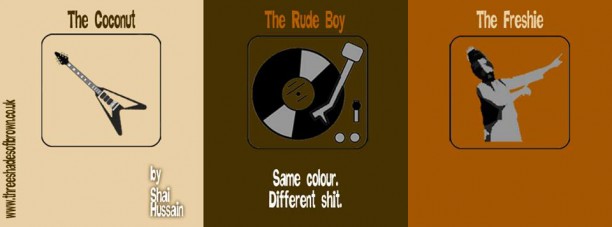 Directed by Shai Hussain, Three Shades of Brown is a comedy web series exploring the lives of three very different British Asians.
Directed by Shai Hussain, Three Shades of Brown is a comedy web series exploring the lives of three very different British Asians.
Already selected to be screened for the New York Film Festival, the London based web series explores what happens when Rude Boy Nas (an Asian who thinks he is “black”), Freshie Ravi (an Asian who is just too Desi) and Coconut Harry (an Asian who thinks he is “white”) move in together.
Not only filling the niche of much needed British Asian drama, Three Shades of Brown is also breaking the stereotype of Asians portrayed as the other- something profusely depicted in media.
As one random reviewer put it:
“Where’s the poverty? The honour killings? The forced marriages? The terrorists? This isn’t Asian at all!”
Scheduled to go online on the 14th of April 2014, 6pm BST, BollySpice were invited to preview 8 webisodes, with each being 3-6 minutes in duration.
Let’s begin with the problem of stereotypes.
“Rude Boy”.
“Freshie”.
“Coconut”.
What role do stereotypes play?
Is a stereotype a filter, an easy way to label people and serve as a certain comfort zone?
Is a stereotype perceived the same by each person?
If not, then why have a stereotype in the first place?
I argue that stereotypes conjure up a different image for each person, can be derogatory or even a compliment and create a false sense of a comfort zone.
In the context of Three Shades of Brown, an Asian who is not comfortable with their roots may find the term Coconut a sigh of relief. However, the term may also be an insult as it could serve as a judgement based solely on one attribute.
Therefore, how many boxes need to be ticked to be a Rude Boy, a Freshie or a Coconut?
What is interesting about Three Shades of Brown is that it plays with the fluidity of stereotypes and thus far, steps away from the comfort zone.
For instance, Nas the Rude Boy is presented as insecure, unpopular and certainly not a figure who would be threatening in a dark alley. Ravi the Freshie does not have an Indian accent as one may assume. True, Ravi personifies some characteristics of a traditional Indian, but then so does Nas.
The overlap of personalities portray that people cannot be placed neatly into labels. This was a breath of fresh air as this is what makes these characters real and the comfort zone broken.
Performance wise, Muzz Khan as Nas has stolen the show so far.
Admittedly, Nas started off as an annoying character who roams around in his underwear with an accent impossible to understand.
However, Nas’ corny jokes told with a seriously plain face end up making them funny. His vulnerability strangely makes him the strongest character. Not only that, but despite the lack of people skills, he ironically becomes the most emotionally evolved character so far.
Ravi, (Omar Khan) and Harry (Navinder Bhatti) are both strong performance wise, but the characters seem to be warming up for the consequential episodes.
Apart from the highly entertaining cameos by Lena Kaur and Poonam Joshi, the first eight episodes revolve around the three leads.
What could have added to Three Shades of Brown was an extra half a minute or so when exploring the female characters – especially regarding Ravi’s (ex?) girlfriend, as this would have helped the viewer to understand and connect with his dilemma better. Also, perhaps more of the soundtrack would have given the series an extra zing.
However, it is important to note that these points are based on just 40 minutes into the series- which brings us to the important question: does Three Shades of Brown want you coming back for more?
The answer is yes.
Yes – to not only get to know why Harry seems so guarded, Nas so messed up and Ravi so co-dependent; or to anticipate how the three lads experience life with their supposedly assigned labels- but for the jokes too.
Three Shades of Brown has the potential to delve further into the less ventured avenues of British Asian life– the diversity, the clashes and of course, the fuzzy lines of a stereotype- all of this with a funny bone.










